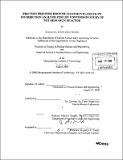Friction pressure drop measurements and flow distribution analysis for LEU conversion study of MIT Research Reactor
Author(s)
Wong, Susanna Yuen-Ting
DownloadFull printable version (22.09Mb)
Other Contributors
Massachusetts Institute of Technology. Dept. of Nuclear Science and Engineering.
Advisor
Lin-wen Hu and Mujid S. Kazimi.
Terms of use
Metadata
Show full item recordAbstract
The MIT Nuclear Research Reactor (MITR) is the only research reactor in the United States that utilizes plate-type fuel elements with longitudinal fins to augment heat transfer. Recent studies on the conversion to low-enriched uranium (LEU) fuel at the MITR, together with the supporting thermal hydraulic analyses, propose different fuel element designs for optimization of thermal hydraulic performance of the LEU core. Since proposed fuel design has a smaller coolant channel height than the existing HEU fuel, the friction pressure drop is required to be verified experimentally. The objectives of this study are to measure the friction coefficient in both laminar and turbulent flow regions, and to develop empirical correlations for the finned rectangular coolant channels for the safety analysis of the MITR. A friction pressure drop experiment is set-up at the MIT Nuclear Reactor Laboratory, where static differential pressure is measured for both flat and finned coolant channels of various channel heights. Experiment data show that the Darcy friction factors for laminar flow in finned rectangular channels are in good agreement with the existing correlation if a pseudo-smooth equivalent hydraulic diameter is considered; whereas a new friction factor correlation is proposed for the friction factors for turbulent flow. Additionally, a model is developed to calculate the primary flow distribution in the reactor core for transitional core configuration with various combinations of HEU and LEU fuel elements.
Description
Thesis (S.M. and S.B.)--Massachusetts Institute of Technology, Dept. of Nuclear Science and Engineering, 2008. Page no. "2" used twice. Cataloged from PDF version of thesis. Includes bibliographical references (p. 147-150 [i.e. p. 148-151]).
Date issued
2008Department
Massachusetts Institute of Technology. Department of Nuclear Science and EngineeringPublisher
Massachusetts Institute of Technology
Keywords
Nuclear Science and Engineering.